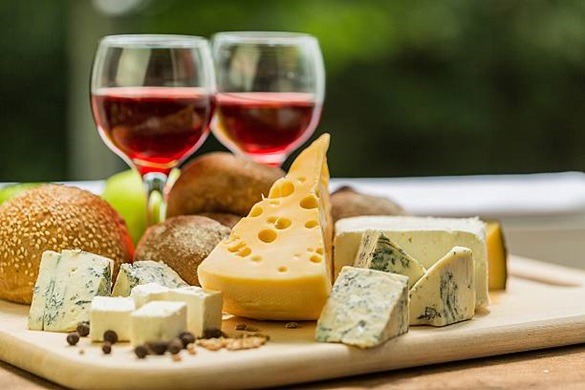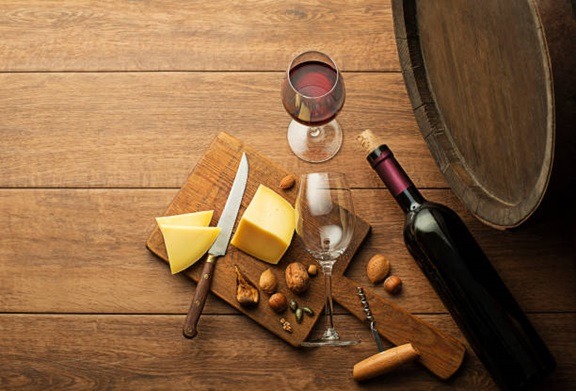Is there a more classic match than wine and cheese? They complement one another perfectly and are the ideal way to begin, finish, or just enjoy a snack. Despite popular opinion, not all wines and cheeses go well together. While the worst combinations might leave us with an unpleasant aftertaste on our lips, the greatest ones balance out the acidity, weight, strength of flavor, and saltiness or sweetness.
There are always interesting exceptions to the test, but generally speaking, we love to explore the proverb “if it grows together, it goes together” by pairing wines with cheeses from the same region.
Although pairing wine and cheese is a sophisticated food and beverage option, many people are unaware that some pairings simply don’t work. Understanding the characteristics that set one type of wine apart from the others and how it will interact with particular types of cheeses is important for creating great cheese, and wine pairings like Crown Royal Peach go well with Asiago.
Here is a helpful guide to provide you with a place to start when pairing your favorite wines with soon-to-be favorite cheese in order to remove a lot of the guesswork from the pairing.
What You Should Know About Wine And Cheese Pairings
- A nice, “safe” place to start when pairing wines and cheeses are with products from the same region. For instance, a potent Parmesan and a fine Italian Chianti will make for an intriguing combination.
- Keep in mind that tougher cheeses like Cheddar or Parmesan can stand up to more tannic wines. While acidic wines, like a Chardonnay, generally go better with creamy cheeses like Brie. Give sweet wine to go with the salty cheeses (i.e., Blue Cheese and Port).
The Perfect Wine and Cheese Pairings
Wine and cheese are a classic pairing, with different types of wine complementing the flavors and textures of various cheeses. Some popular pairings are mentioned below.
1. Aged Or Sharp Cheddar And Cabernet Sauvignon
Known for its full-bodied, rich flavors and lesser tannins that make up its lighter-bodied counterparts, Cabernet Sauvignon is a versatile classic vine. Dark fruits like plums, cherries, and blackberries, as well as warm spices like vanilla or licorice root, are among the most frequent aromatic elements found in Cabernet Sauvignon.
Cheddar that has aged has a nutty flavor that intensifies with time. Even the toughest bread may be cut with its crumbly, sharp texture, yet often it has an almost buttery consistency despite its salty bite.
The bitterness of these astringent, dry red wines, such as Cabernet Sauvignon, is balanced by aged cheddar, and their powerful flavors are nicely matched by one another in this way.
2. Gouda And Merlot
The wine variety Merlot is in the center of the red color range. Due to its mild tannin, acidity, and alcohol content, this tasty wine is rich and smooth. You can receive flavors like cherry, plum, or raspberry with a tinge of spiciness that has an approachable aftertaste on your tongue.
A cow’s milk cheese with a long history of aging and a robust, savory flavor is Gouda. As it ages, the mild butterscotch or caramel undertones become more apparent, and its texture takes on a crumbly parmesan-like quality.
Wines ranging from white to red pair well with Gouda. Merlot and Gouda share a comparable amount of acidity, which makes for an excellent wine-and-cheese match. Also fantastic with Monterey Jack, Gruyere, and Herb Cheese is Merlot.
3. Roquefort And Syrah
Syrah is a deep, robust wine with a powerful flavor. It is dry and full-bodied without being sour or harsh and is very nicely balanced. This wine pairs well with a variety of foods and has overtones of bacon, smoke, and flowery from the violet flower.
Roquefort has a distinctive aroma and is a tart, creamy blue-veined cheese. Sheep milk’s sweet burnt caramel flavor balances the acrid taste and strong metallic flavor of Roquefort, giving it its distinctive fragrance.
Try pairing Syrah with Roquefort if you want a bolder flavor profile with your red wines. The smokey, meaty flavor of Syrah pairs perfectly with the salty character of Roquefort. Gorgonzola, pecorino, and aged cheese can also be combined with Syrah.
4. Pinot Noir With Gruyere
Pinot Noir is a delicious dry wine that’s perfect for people who like the subtle flavors of fruit and berries combined with wood. They are revived in warmer weather or as an appetizer before dinner because of their tannins, which have a bright acidic flavor.
Gruyère cheese is a milder, creamier kind of Swiss cheese that has a nutty flavor and a lovely yellow color.
Pinot Noir pairs beautifully with nutty cheeses like Gruyere. The flavor of this medium-firm cheese is complemented by the berry fruit in the rich red wine without being overpowered by it. They both had exactly the right amount of flavor and complexity to avoid getting monotonous after one taste.
5. Parmesan And Chianti
The aromas and flavors in Chianti Wine are expertly balanced. Anyone who has tried Chianti knows that depending on its characteristics, the wine has a distinctive flavor that includes red fruits, dry herbs, balsamic vinegar, smoke, or game. The encounter could also reveal bolder qualities and nuances, like preserved tart cherries in fine wines.
The taste and texture of parmesan cheese are amazing. It is the appropriate accompaniment for a variety of cuisines and wines because it provides the ideal combination of salty, acidic, sweet, and spicy qualities.
Chianti pairs well with hard Italian cheeses because of its fairly rich and hefty flavor. People advise parmesan cheese because of its nutty qualities to counterbalance the fruity notes in Chianti. Another fantastic choice is Chianti with Pecorino.
Final Thoughts
Given how similar cheese and wine are to one another, it makes sense that we often drink them together. Both have a wide variety of styles where national and regional traditions mix with changing natural factors like soil, climate, and other influences, so one year’s crop may be significantly different from the last. The temperature at which they are consumed, as well as pests and molds, each have their effects.
Individual character is shaped by production techniques, how they are stored and aged – or not – and by the love and care as well as the whims of the people who produce them.



